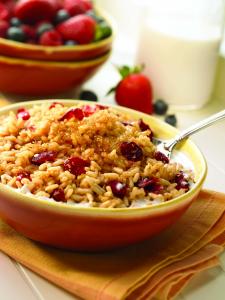Bringing Back Breakfast: Choosing healthy breakfast cereals
While breakfasts like omlettes and oatmeal sound great, many of us don’t have the time to cook breakfast in the morning. Instead, we reach for cereal and a carton of milk. Luckily, breakfast cereal can be a healthy way to get your day started especially since many are fortified with vitamins and minerals. However, some cereals are better classified as dessert, giving you a morning sugar rush followed by a hungry stomach hours before lunch. With all the options out there and some cereals claiming to be healthier than others it can get confusing knowing which are the better choices. Here are some general tips for navigating the cereal aisle:
Make choices that will keep your stomach full
Not all grains are created equally. While a serving of a refined grain cereal and a serving of a whole grain cereal may have the same amount of calories, the serving of whole grain cereal will most likely keep you full for longer. In addition to warding off late morning hunger, whole grains also contain more vitamins and minerals naturally since they aren’t processed. Breakfast is an easy meal to get in a serving of whole grains for the day. One serving of whole grains = 16 grams – easily attainable in a bowl of cereal! When looking at the ingredient list, look for whole grains or oats as the first ingredient.
The Dietary Guidelines recommend Americans consume at least 25 grams of fiber a day. Again, cereal comes to the rescue! Aim for cereals with at least 3 grams of fiber per serving.
Avoid the sugar rush
While Lucky the Leprechaun and the dog on the Cookie Crisp cereal boxes bring back fond memories of childhood breakfast commercials during Sunday morning cartoons, their sugar content put them in the same category as eating cookies for breakfast. Tasty, yes, but not the healthiest or the most filling. Look for cereals with 9 grams or less of sugar that ALSO contain at least 3 grams of fiber and are mostly whole grain. Some cereals like Rice Krispies only have 3 grams of sugar per serving, but have 0 grams of fiber and no whole grains. Needless to say, it won’t be long until you hear your stomach grumbling again. The opposite can be true as well; some cereals contain slightly more than 9g of sugar, but are packed with fiber and whole grains, making them healthy options.
Size check
Not all cereals use the same serving size: most are either ¾ or 1 cup of dry cereal; some like mini wheat’s are even more specific saying exactly how many wheat squares are in 1 serving. The number of calories, grams of sugar, and amount of vitamins and minerals you consume depends on how much of the cereal you eat. Because cereal bowls are usually much larger than one serving, it’s important not to just keep pouring until the bowl is completely full. Instead, for one cup of cereal, pour a fist-sized amount. Not filling enough? Instead of pouring more cereal, add in fresh or frozen fruit to bulk up the volume and the nutrition.
Don’t be fooled by advertising ploys
Some cereals claim to be “low fat” and will help you lose weight. Truth is most cereals are low in fat. Instead of looking for weight loss promises on the front, look at the nutrition facts and ingredient label on the side. If weight loss is your goal, keep your focus on finding breakfast cereals that will keep you full for longer; also be sure to check serving sizes.
Fruit containing cereals: while some may be whole grain and low in sugar, chances are that these cereals are mostly refined grains and the “fruit” is freeze-dried and sugar concentrated. The best option is always to add your own fresh or even frozen fruit. Sliced up bananas or frozen blueberries not only add a nutritious punch, but will also add a bit of sweetness.
Don’t forget the milk!
Breakfast is a great time to meet some of your daily calcium needs. Enjoy your cereal with fat-free or 1% milk. If you are vegan, lactose-free, or just like a change, pour on some almond milk instead.
Want a boost of protein? I sometimes add half a tablespoon of natural peanut butter to the mix.
Other great resource? Cereals in the dining halls with the Sargent Choice sticker on them. These cereals are Sargent Choice approved because they contain whole grains and fiber and are low in sugar.
Have a favorite healthy breakfast cereal? Share it with us by leaving a comment below!


4 Comments
Tim posted on February 16, 2012 at 1:28 pm
Finding a healthy breakfast cereal can definitely be tricky, especially with all the misleading health claims you find on packages these days. I tend to like All Bran Bran Buds because it’s extremely high in fiber. It has more sugar than I would prefer, at 8 grams per serving, but I just add a little fat and protein to my breakfast, usually eggs, to lessen the glycemic impact. I really like your peanut butter idea, so I’m going to have to try that.
mee posted on March 3, 2012 at 6:50 am
Nice Paragraph i like it so much it is so healthy THANK YOU SO MUCH
Leak Detection UK posted on March 6, 2012 at 2:53 am
Morning breakfast makes us healthy and plays very important role in the life.I asked some my friend about the healthy breakfast but i didn’t find so i think its so useful for me.
distillery equipment posted on July 27, 2022 at 3:08 am
nice to meet you